What is this life if full of care ,
we have no time to stand and stare.
W H Davies.
|
Birds
29/03/19
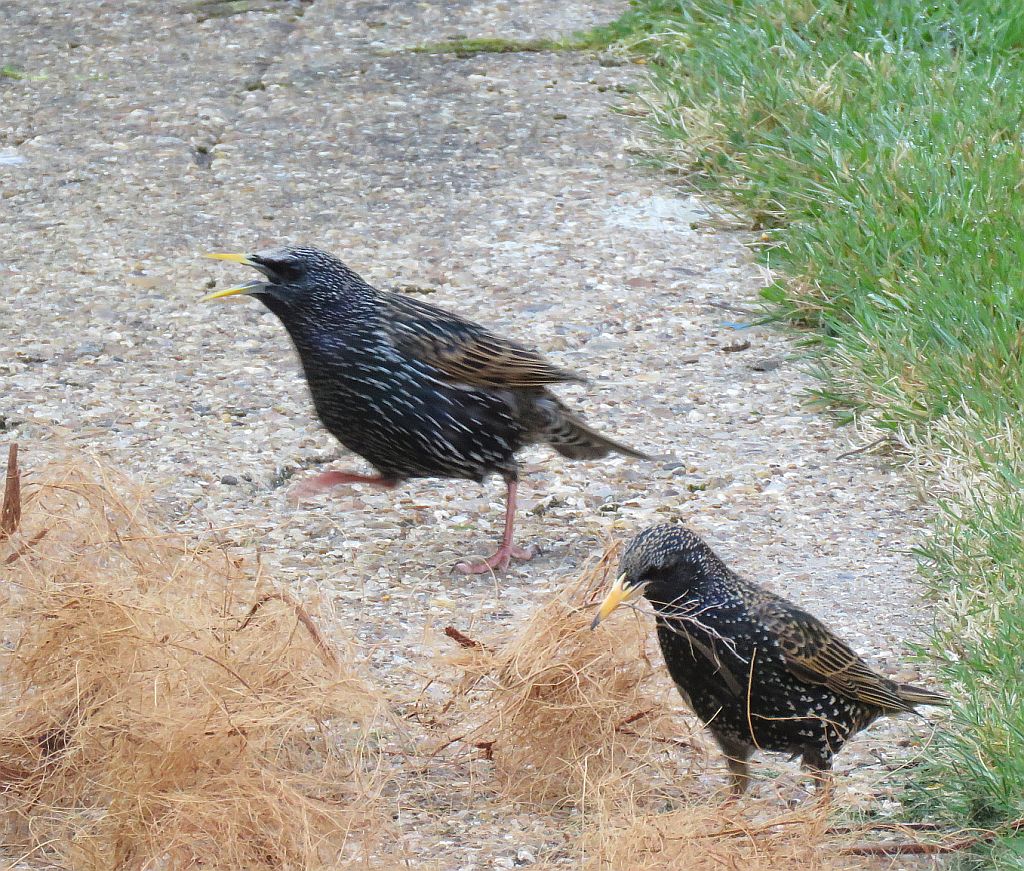 It was the turn of the Starling today to set about the hanging baskets and strip the co-co liners of their fibres.They are taking anything and everything that they can find in the garden for nesting material. So I placed another old hanging basket co-co liner on the path with a few twigs.
It was the turn of the Starling today to set about the hanging baskets and strip the co-co liners of their fibres.They are taking anything and everything that they can find in the garden for nesting material. So I placed another old hanging basket co-co liner on the path with a few twigs. 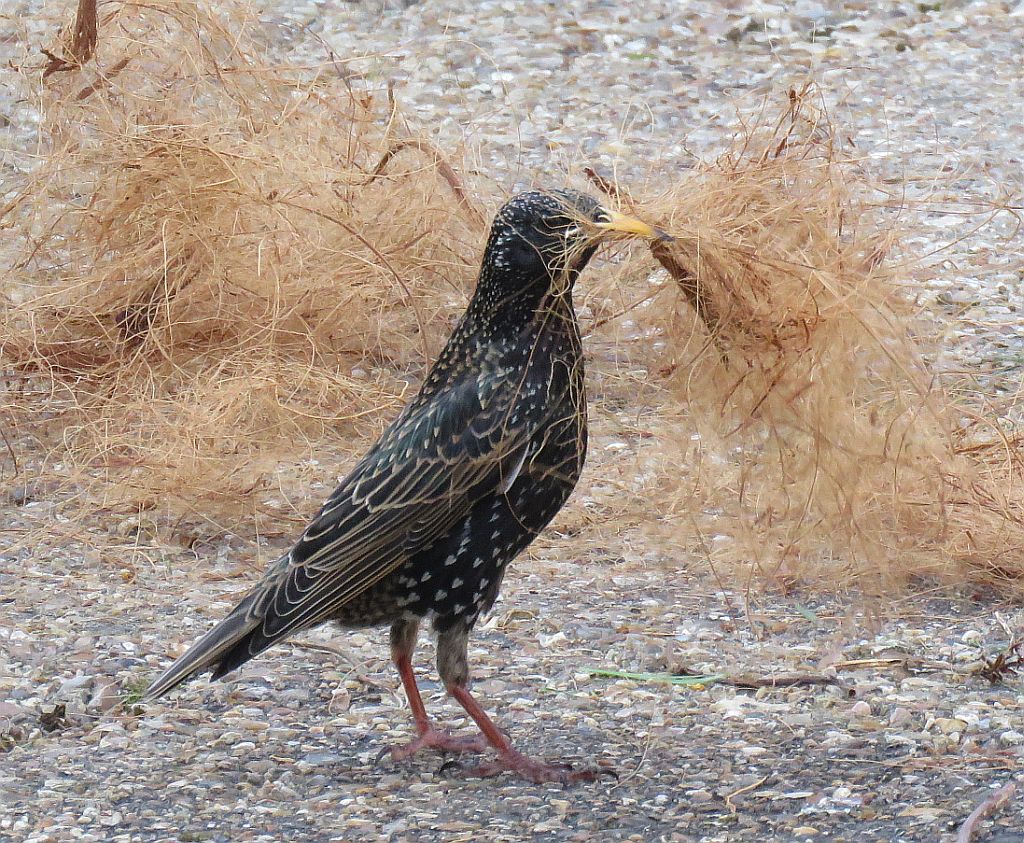 Male (Blue base to the bill) and Female (Pink base to the bill) appeared wihin minutes,and it was being transported away.As Noah said "Build and they will come". Starling copulation was also seen to take place on my Pergola,shocking on a Friday morning before breakfast . In the afternoon a Grey Wagtail flew over calling. Male (Blue base to the bill) and Female (Pink base to the bill) appeared wihin minutes,and it was being transported away.As Noah said "Build and they will come". Starling copulation was also seen to take place on my Pergola,shocking on a Friday morning before breakfast . In the afternoon a Grey Wagtail flew over calling.
27/03/19
In Area 1 at Ludgrove, 2 Lapwing were flying over, a Skylark was singing in the sunshine, 2 Canada Goose were on the flooded field and a Buzzard was enjoying the thermals.
26/03/19
 Paul Bright-Thomas was in Area 4 and saw a male Chiffchaff calling by the river and a Linnett flew over his garden calling. In Area 10 a male Blackcap was singing from the hedge in the Car Park field, 3 Sand Martin were seen and a male Chiffchaff was singing high in the trees.Spring has arrived.
Paul Bright-Thomas was in Area 4 and saw a male Chiffchaff calling by the river and a Linnett flew over his garden calling. In Area 10 a male Blackcap was singing from the hedge in the Car Park field, 3 Sand Martin were seen and a male Chiffchaff was singing high in the trees.Spring has arrived.
25/03/19
This morning in Area 5 a Greylag Goose flew over calling. In Area 10, a pair of Great Spotted Woodpecker were seen mating in the big Willow near the Green bridge where the Emm Brook meets the Loddon by Trevor Guyatt and
2Green Woodpecker were in the Car Park field seen by Suren Akkaraju.
24/03/19
In the Emm by Meadow Road Bridge in Area 4 a Little Egret was seen looking for its breakfast by Malcolm Dunmore. In Area 10 a male Blackcap was singing by the Green bridge and a Tawny Owl was heard calling . Seen by Fraser Cottington.
23/03/19
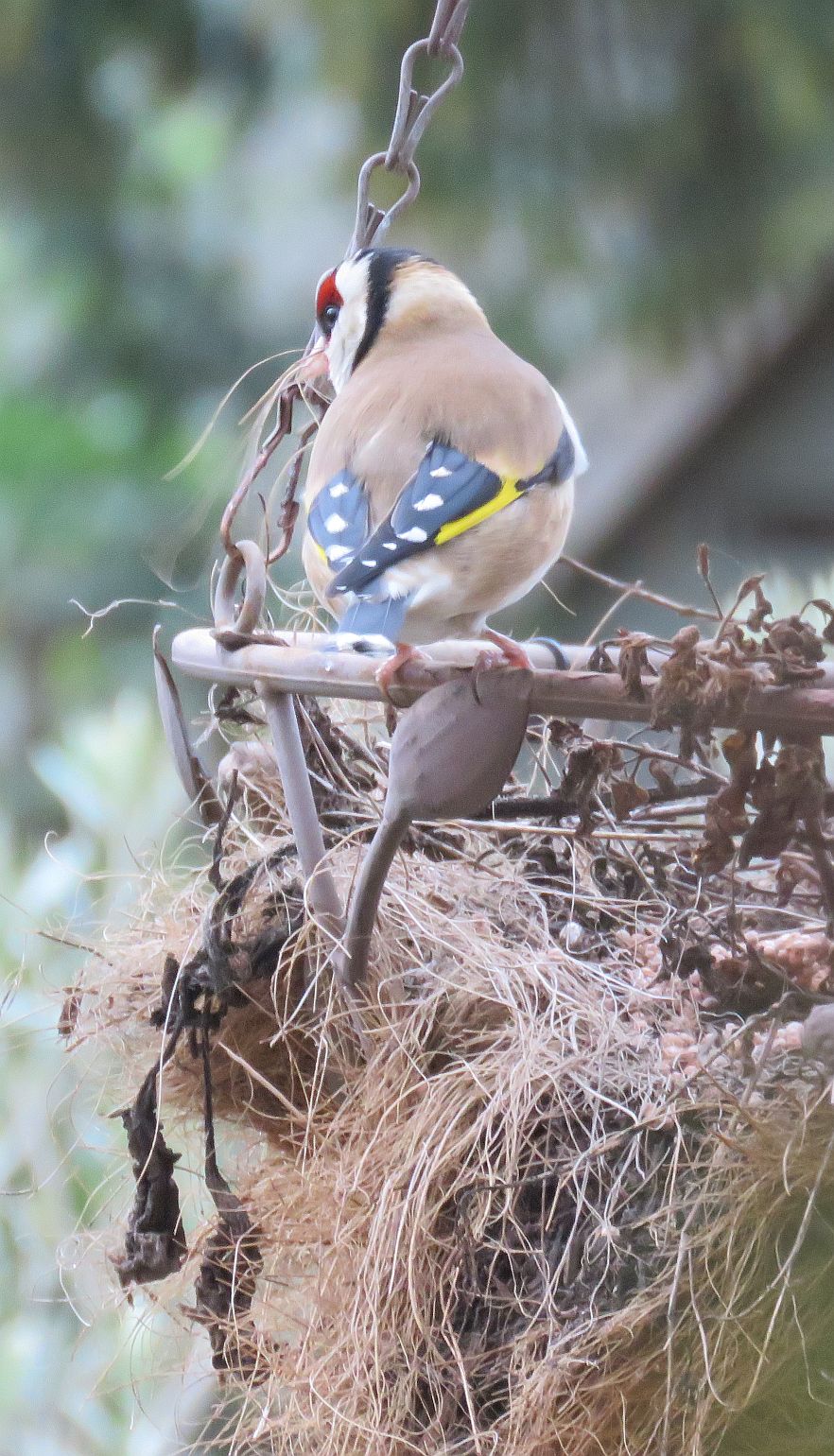 In my Area 5 garden this morning, a pair of Goldfinch were visiting the hanging baskets and stripping the co-co liners of their fibres. I assume for nesting material.A Chiffchaff ,
In my Area 5 garden this morning, a pair of Goldfinch were visiting the hanging baskets and stripping the co-co liners of their fibres. I assume for nesting material.A Chiffchaff ,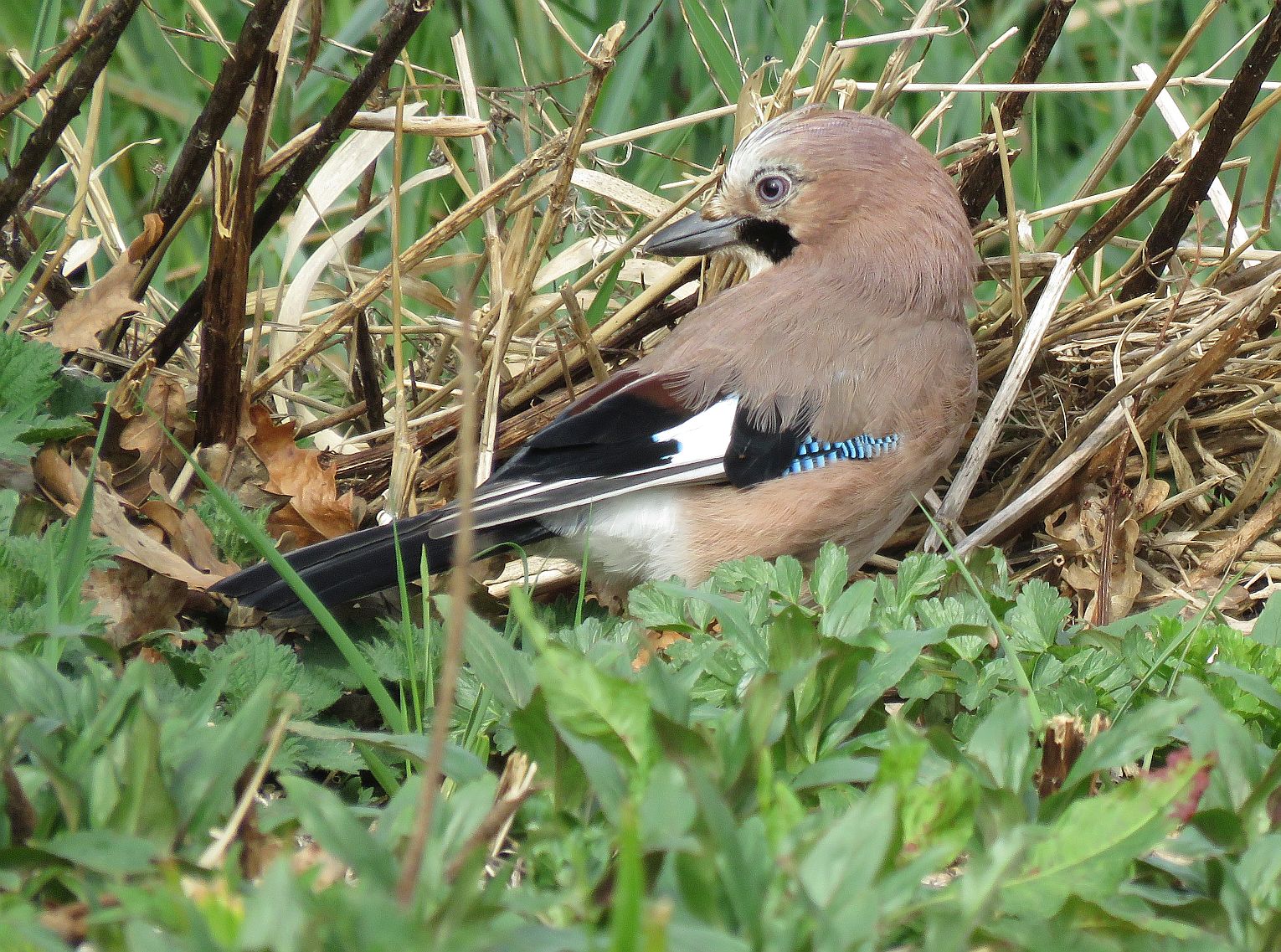 3 Male Mallard , a drumming male Great spotted Woodpecker , and a Jay were seen during the lunch time Litter Pick. A Redwing was seen near the Emm Brook in Area 10 by Brian Bennett. 3 Male Mallard , a drumming male Great spotted Woodpecker , and a Jay were seen during the lunch time Litter Pick. A Redwing was seen near the Emm Brook in Area 10 by Brian Bennett.
22/03/19
20+ Sand Martin were seen heading south west over the Dinton Activity Centre in Area 10 by Peter Scudamore. The first of the year.
20/03/19
On what I believe to officially be the first day of Spring a male Robin was singing from early morning in my Area 5 garden Ash tree.It was joined silently by 5 Goldfinch getting ready to raid the feeders and a calling Great Tit .
19/03/19
Flying over Emmbrook Road and dropping down to the river in Area 6 a Grey Heron was seen at 16:30.
17/03/19
 Finally the wind abated and the sun came out, in my Area 5 garden a female Great spotted Woodpecker was on the fat feeder, a male Chaffinch was seen ,( a bit of a rarity these days) , also seen was a male House Sparrow .The resident Buzzard was flying around the back of Windmill School.
Finally the wind abated and the sun came out, in my Area 5 garden a female Great spotted Woodpecker was on the fat feeder, a male Chaffinch was seen ,( a bit of a rarity these days) , also seen was a male House Sparrow .The resident Buzzard was flying around the back of Windmill School. 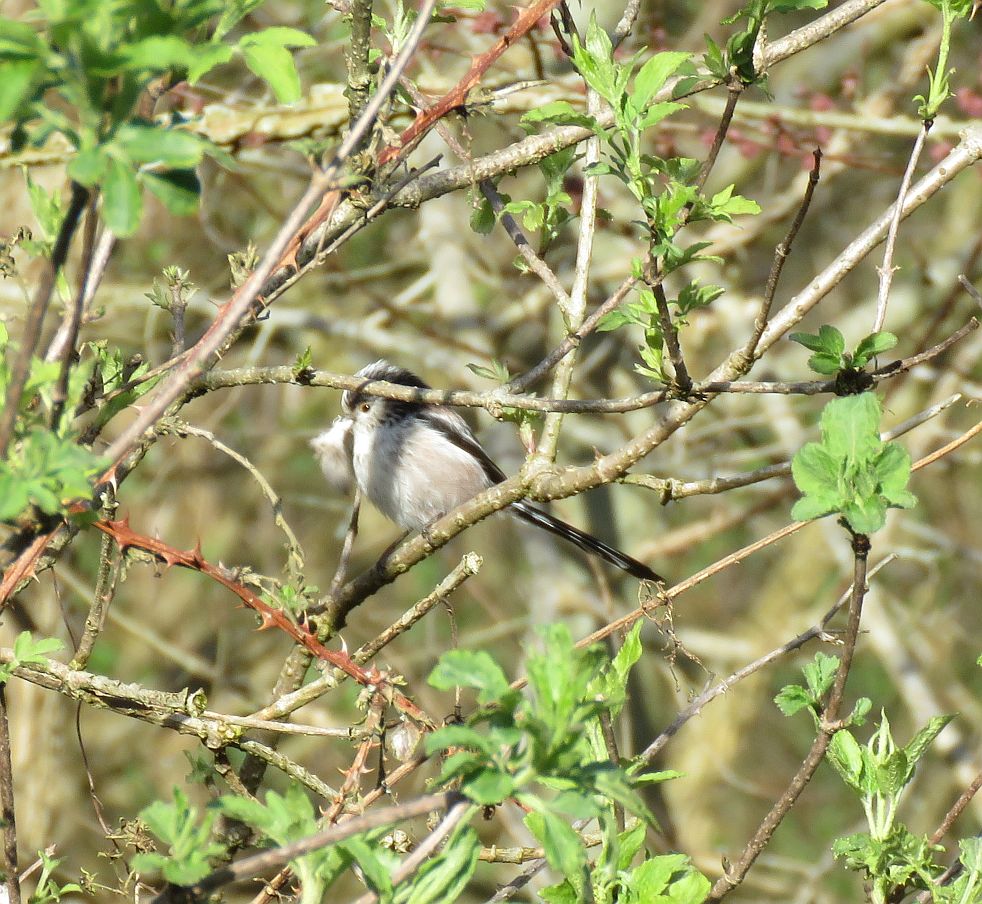 A Long tailed Tit was seen flying around to a Bramble bush by the river with nest building material (feathers).A sure sign of Spring
The male and female work together to build their nest, taking nearly three weeks
The nest is shaped rather like a bottle, usually with a roof and an entrance hole near the top. They construct it in a bush or in the fork of a tree, from moss, camouflaged with lichen with interwoven cobwebs and sometimes bits of paper stuck on the outside.To make the inside cosy for the eggs and chicks, a feather lining is added. They need a lot of feathers - as many as 1,500!
A Long tailed Tit was seen flying around to a Bramble bush by the river with nest building material (feathers).A sure sign of Spring
The male and female work together to build their nest, taking nearly three weeks
The nest is shaped rather like a bottle, usually with a roof and an entrance hole near the top. They construct it in a bush or in the fork of a tree, from moss, camouflaged with lichen with interwoven cobwebs and sometimes bits of paper stuck on the outside.To make the inside cosy for the eggs and chicks, a feather lining is added. They need a lot of feathers - as many as 1,500! 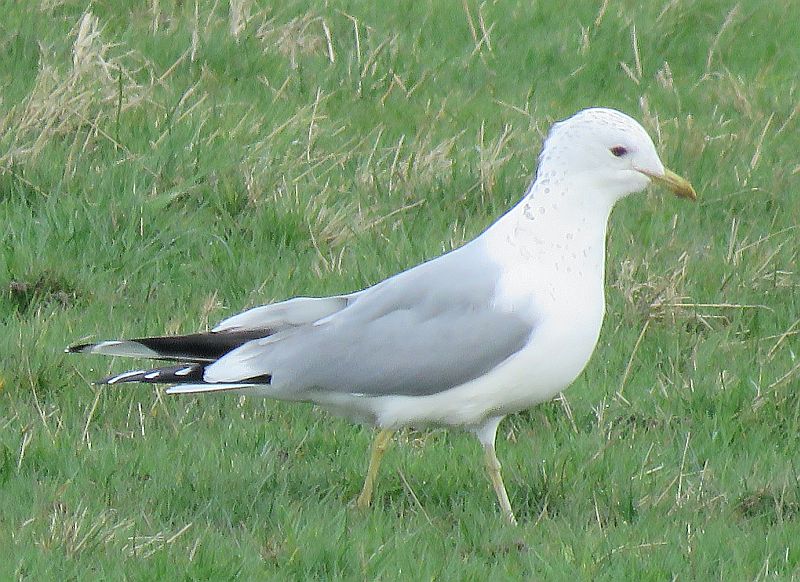 In Area 1, 2 Lesser Black backed Gull were feeding in the Horse fields. A Chiffchaff was heard calling from trees near the Emm. In Area 1, 2 Lesser Black backed Gull were feeding in the Horse fields. A Chiffchaff was heard calling from trees near the Emm.
14/03/19
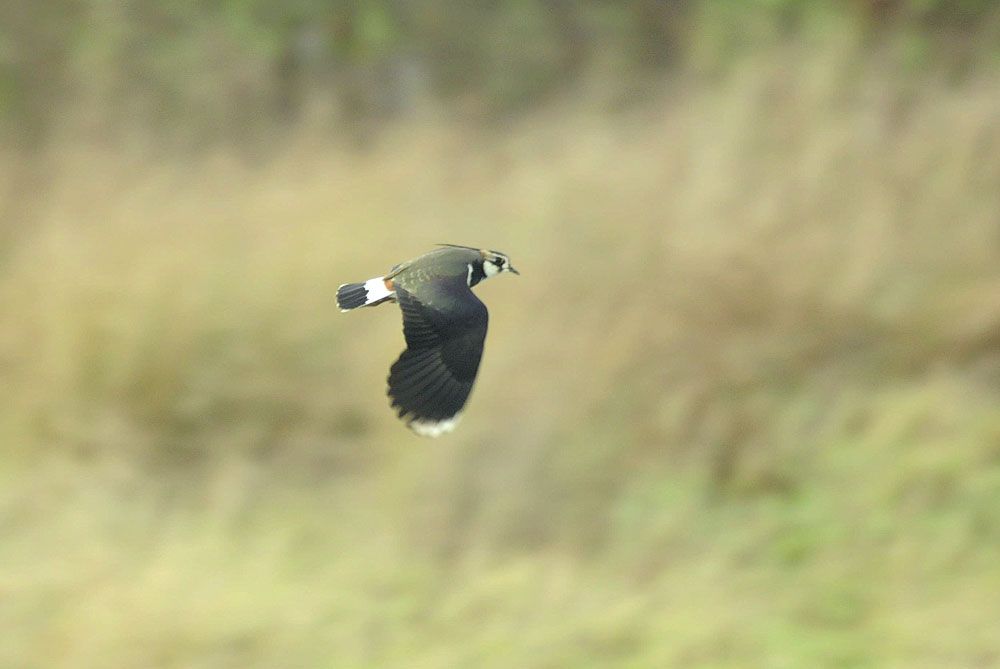 Around the fields at Ludgrove in Area 1 today at lunchtime a
Lapwing was displaying. The lapwing has a spectacular songflight. The male wobbles, zigzags, rolls and dives while calling to advertise his presence to rival males and potential mates. Its ‘peewit’ call notes the arrival of spring.
Around the fields at Ludgrove in Area 1 today at lunchtime a
Lapwing was displaying. The lapwing has a spectacular songflight. The male wobbles, zigzags, rolls and dives while calling to advertise his presence to rival males and potential mates. Its ‘peewit’ call notes the arrival of spring.
13/03/19
On what has been a wet,windy and miserable week with Storm Gareth creating havoc, and apparently more to come, a
Peregrine was seen dispersing everything over the Area 10 car park field by Jenny Vaughan it then flew off towards Black Swan Lake.
10/03/19
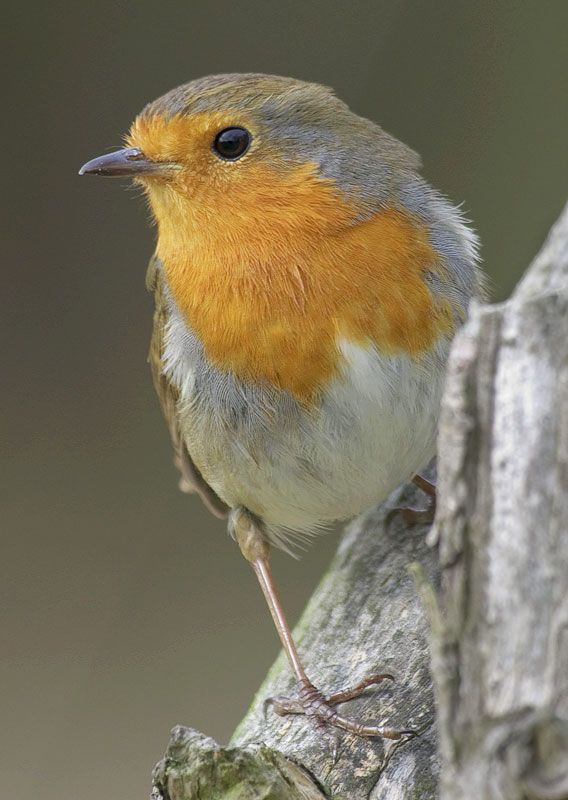 3 Ring-necked Parakeet were seen flying east over the Area 10 car park field by Finley Hutchinson.A Robin was singing by Dragonfly Bridge in Area 5.
3 Ring-necked Parakeet were seen flying east over the Area 10 car park field by Finley Hutchinson.A Robin was singing by Dragonfly Bridge in Area 5.
09/03/19
 In Area 4 a Buzzard was perched in the Balancing pond and a Nuthatch and Great spotted Woodpecker were seen. In Area 5 a pair of Mallard were on the river, a Coal Tit was at my garden feeders feeders, with Great Tit and Blue Tit . 2 Nuthatch were also seen . By Ripplestream Bridge, what I believe to be a pair of a Sparrowhawk flew over. Females are larger than males, as with all birds of prey.In Area 1 at Heathlake on the water were Mute Swan ,
Tufted Duck , Shoveller , Coot and Canada Goose , on the Island 4 Grey Heron were seen with 2 nesting. Still in Area 1 but at Ludgrove 8 Teal were on the flooded field.
In Area 4 a Buzzard was perched in the Balancing pond and a Nuthatch and Great spotted Woodpecker were seen. In Area 5 a pair of Mallard were on the river, a Coal Tit was at my garden feeders feeders, with Great Tit and Blue Tit . 2 Nuthatch were also seen . By Ripplestream Bridge, what I believe to be a pair of a Sparrowhawk flew over. Females are larger than males, as with all birds of prey.In Area 1 at Heathlake on the water were Mute Swan ,
Tufted Duck , Shoveller , Coot and Canada Goose , on the Island 4 Grey Heron were seen with 2 nesting. Still in Area 1 but at Ludgrove 8 Teal were on the flooded field. In Area 10 a Chiffchaff was again singing by the bridge over the Emm at the car park field.A returning migrant and a sure sign of Spring. In Area 10 a Chiffchaff was again singing by the bridge over the Emm at the car park field.A returning migrant and a sure sign of Spring.
07/03/19
The wind was gusting at 31.1mph locally but
a Bullfinch and a Greenfinch were seen in the car park field in Area 10 by Nick Kightley.
06/03/19
In Area 10 a Goldcrest was seen by the bridge over the Emm near Lavell’s car park by Bruce Irvine. A Chiffchaff was again singing near car park field seen by Brian Bennett.
04/03/19
2 Chiffchaff were heard singing in the hedgerow from the car park field in Area 10 by Fraser Cottington.
03/03/19
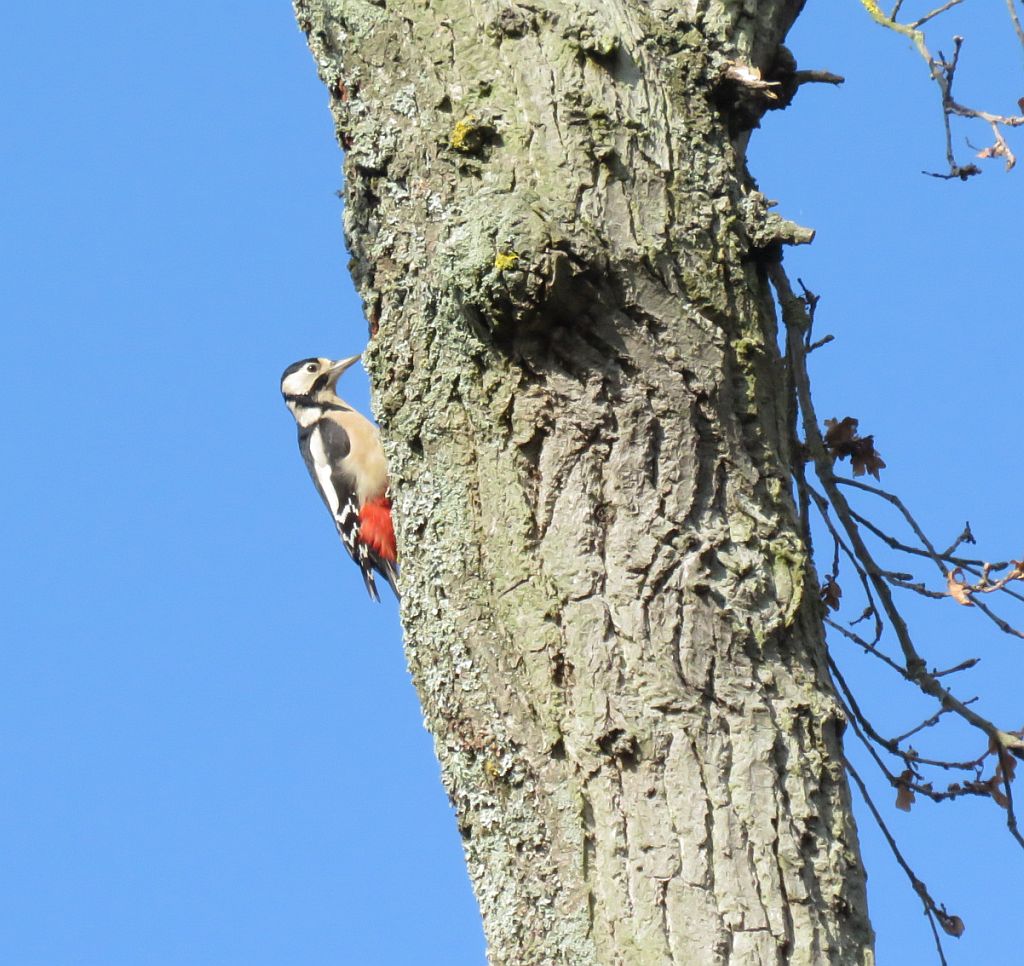 In Area 5 the Great spotted Woodpecker was drumming for all he was worth. A Carrion Crow was wandering around my lawn. In Area 1, 2 Grey Heron were on the flooded fields with 2 pairs of Mallard .A Chiffchaff was seeen in Area 10 by Fraser Cottington.
In Area 5 the Great spotted Woodpecker was drumming for all he was worth. A Carrion Crow was wandering around my lawn. In Area 1, 2 Grey Heron were on the flooded fields with 2 pairs of Mallard .A Chiffchaff was seeen in Area 10 by Fraser Cottington.
01/03/19
A Mistle Thrush was singing in the Area 10 carpark field by Richard Marsh.
|
Insects
31/03/19
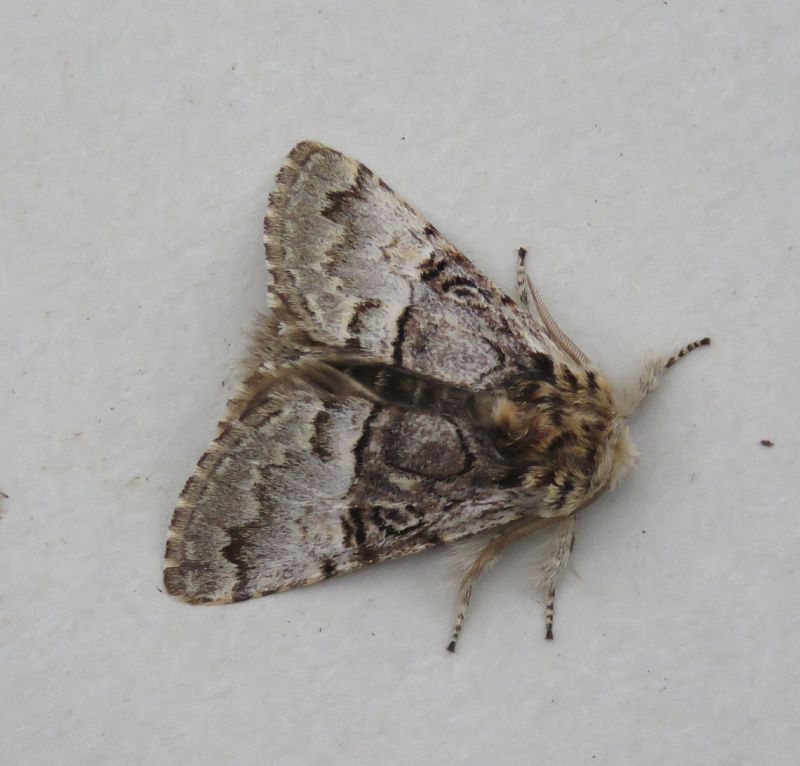 With reasonable temperatures the mothtrap was out again overnight. It was a reasonable catch that included, 1 Nut-tree Tussock Colocasia coryli , a Brindled Beauty Lycia hirtaria , 1 Frosted Green Polyploca ridens , 2 Clouded Drab Orthosia incerta, a Mottled Pug Eupithecia exiguata , 10 Common Quaker Orthosia cerasi, 5 Small Quaker Orthosia cruda
With reasonable temperatures the mothtrap was out again overnight. It was a reasonable catch that included, 1 Nut-tree Tussock Colocasia coryli , a Brindled Beauty Lycia hirtaria , 1 Frosted Green Polyploca ridens , 2 Clouded Drab Orthosia incerta, a Mottled Pug Eupithecia exiguata , 10 Common Quaker Orthosia cerasi, 5 Small Quaker Orthosia cruda
 a
Twin spotted Quaker Anorthoa munda , 2 Hebrew Charecter Orthosia gothica, 1 Light Brown Apple Moth Epiphyas postvittana and 2 Conistra vaccinii . A
Common green lacewing Chrysoperla carnea and a Common Wasp Vespula vulgaris were also lured in by the light. a
Twin spotted Quaker Anorthoa munda , 2 Hebrew Charecter Orthosia gothica, 1 Light Brown Apple Moth Epiphyas postvittana and 2 Conistra vaccinii . A
Common green lacewing Chrysoperla carnea and a Common Wasp Vespula vulgaris were also lured in by the light.
30/03/19
 A walk down to Woosehill Community Centre in Area 5 at lunchtime , to see the Greenways Project display, produced a good deal of Butterfly activity. By the pond a Small Tortoiseshell Aglais urticae
was seen in the afternoon sunshine. This was quickly followed by a Small White Pieris rapae.A male Brimstone Gonepteryx rhamni was also seen. On the way back 2, Speckled Wood Pararge aegeria were seen spiralling together under the trees. This is a 100% increase to the FOTEB Butterfly list whicn now rises to 6 species.
A walk down to Woosehill Community Centre in Area 5 at lunchtime , to see the Greenways Project display, produced a good deal of Butterfly activity. By the pond a Small Tortoiseshell Aglais urticae
was seen in the afternoon sunshine. This was quickly followed by a Small White Pieris rapae.A male Brimstone Gonepteryx rhamni was also seen. On the way back 2, Speckled Wood Pararge aegeria were seen spiralling together under the trees. This is a 100% increase to the FOTEB Butterfly list whicn now rises to 6 species.
29/03/19
Disturbed in my Area 5 garden this morning was a Peacock Inachis io
butterfly. The 3rd species for the year.
24/03/19
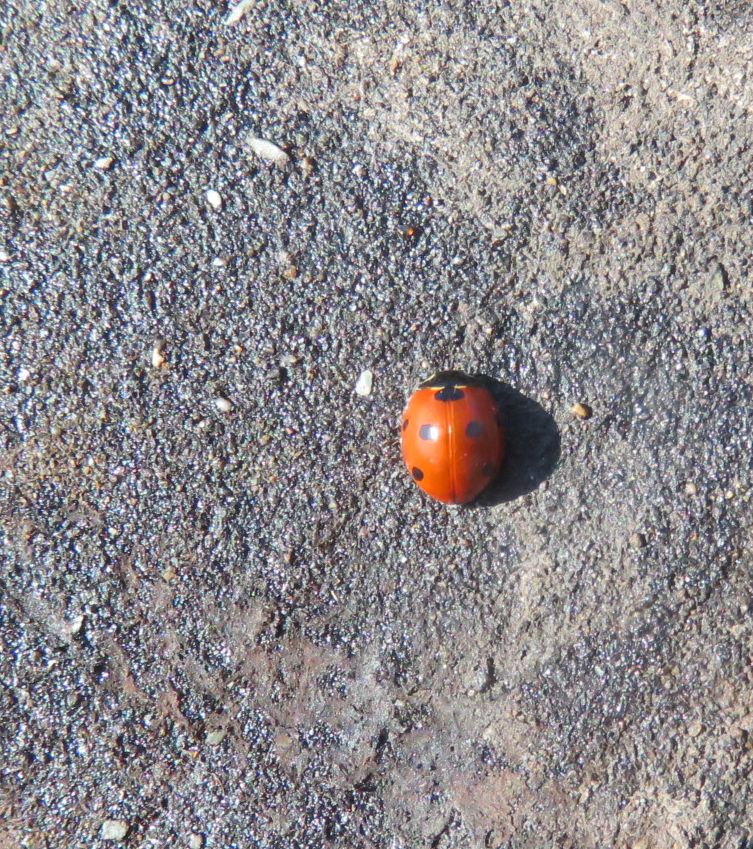 Whilst tidying the garden in Area 5, in the afternoon sunshine a Ruby Tiger Phragmatobia fuliginosa caterpillar and my first 7 Spot Ladybird Coccinella septempunctata of the year were seen .
Whilst tidying the garden in Area 5, in the afternoon sunshine a Ruby Tiger Phragmatobia fuliginosa caterpillar and my first 7 Spot Ladybird Coccinella septempunctata of the year were seen .
23/03/19
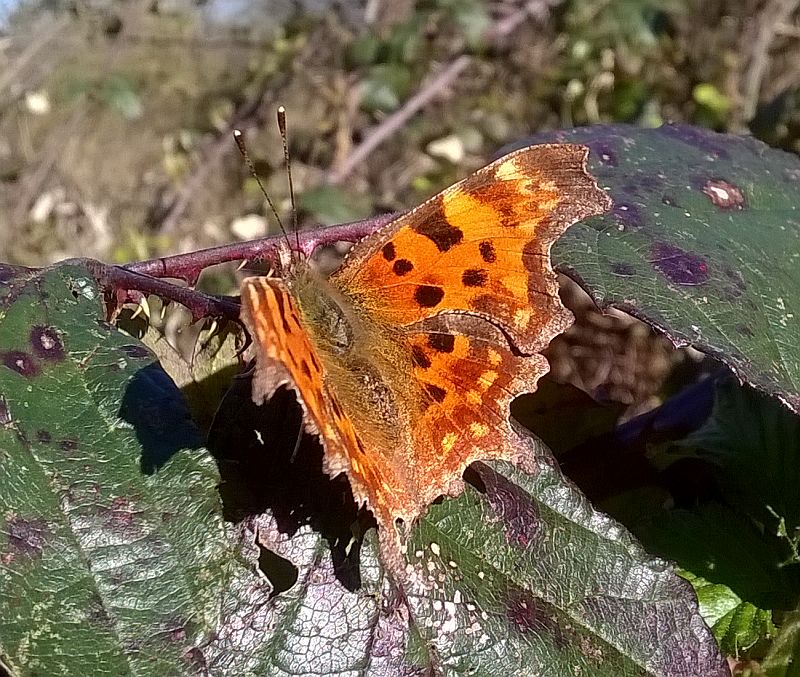 With the temperature reaching 13.8C at lunch time, it was probably no suprise that Brimstone Gonepteryx rhamni and Comma Polygonia c-album Butterflies were seen during the Litter Pick.
With the temperature reaching 13.8C at lunch time, it was probably no suprise that Brimstone Gonepteryx rhamni and Comma Polygonia c-album Butterflies were seen during the Litter Pick. 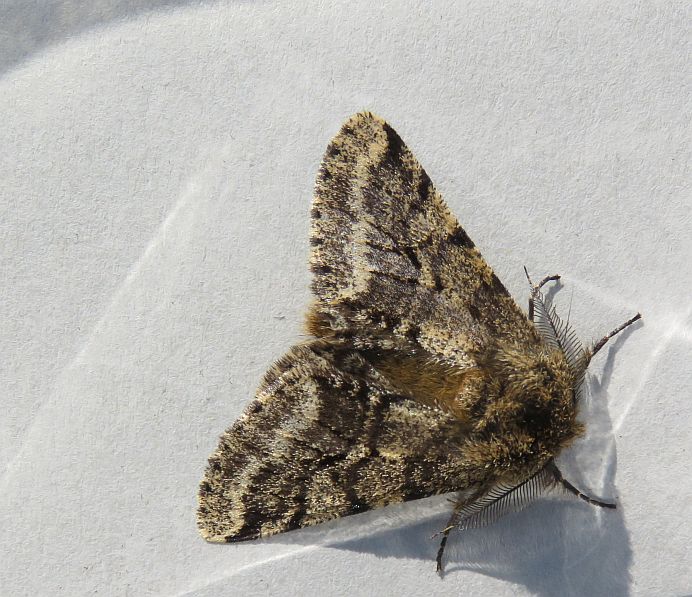 The moth trap was put out in my Area 5 garden overnight. Highlight was 2 male Brindled Beauty Lycia hirtaria also trapped and then later released were 2 Early Grey Xylocampa areola , 7 Hebrew Character Orthosia gothica , 8 Common Quaker Orthosia cerasi , 3 Small Quaker Orthosia cruda , 2 Lead Coloured Drab Orthosia populeti and a probable Pale Pinion Lithophane socia .
The moth trap was put out in my Area 5 garden overnight. Highlight was 2 male Brindled Beauty Lycia hirtaria also trapped and then later released were 2 Early Grey Xylocampa areola , 7 Hebrew Character Orthosia gothica , 8 Common Quaker Orthosia cerasi , 3 Small Quaker Orthosia cruda , 2 Lead Coloured Drab Orthosia populeti and a probable Pale Pinion Lithophane socia .
21/03/19
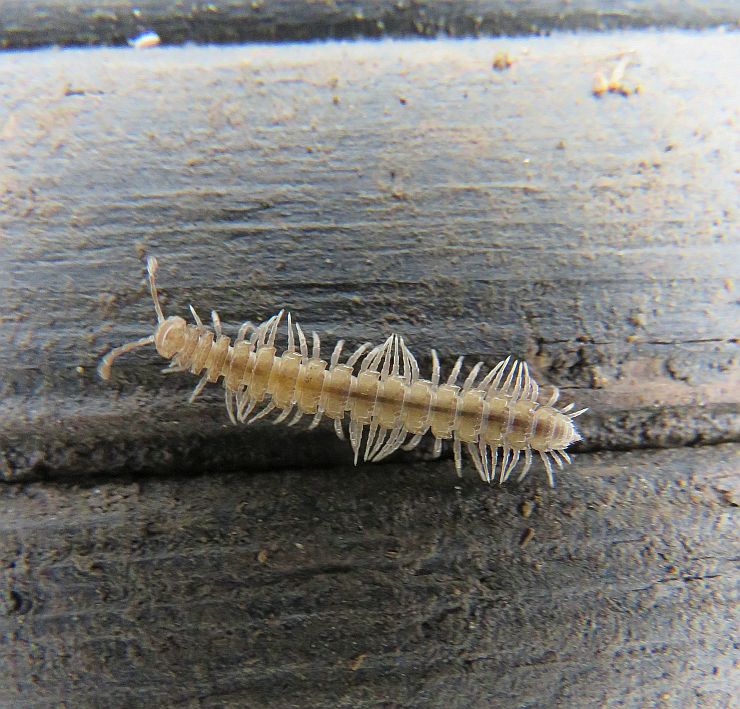 Millipedes and Centipedes are a much overlooked group of Insects, however whilst on a Bug Hunt in Area 10 both Polydesmus angustus and
Millipedes and Centipedes are a much overlooked group of Insects, however whilst on a Bug Hunt in Area 10 both Polydesmus angustus and 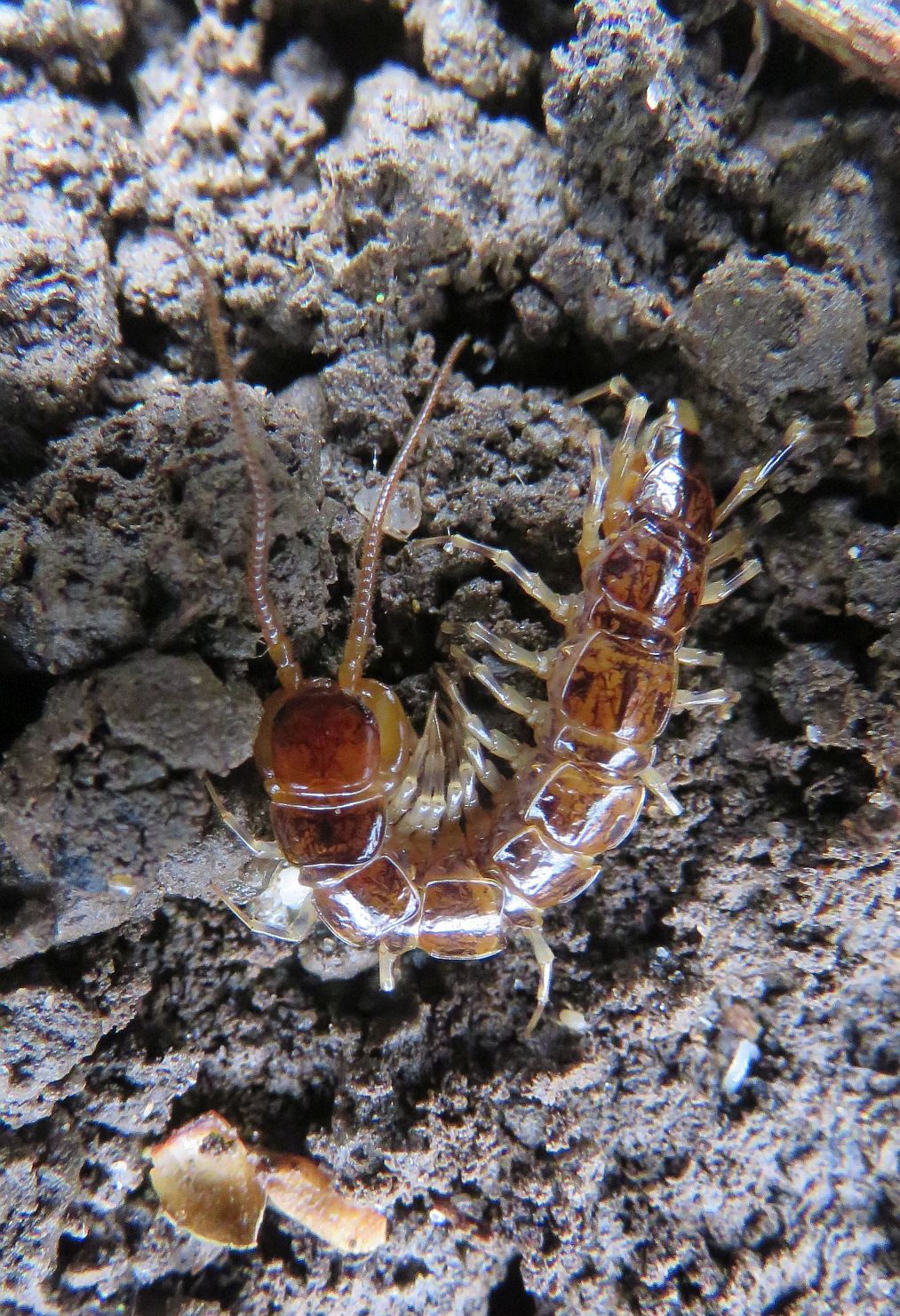 Brown Centipede Limacus flavus were seen under rotting logs.Also seen were Pill Woodlouse Armadillidium vulgare and Common Shiny Woodlouse Oniscus asellus. Brown Centipede Limacus flavus were seen under rotting logs.Also seen were Pill Woodlouse Armadillidium vulgare and Common Shiny Woodlouse Oniscus asellus. 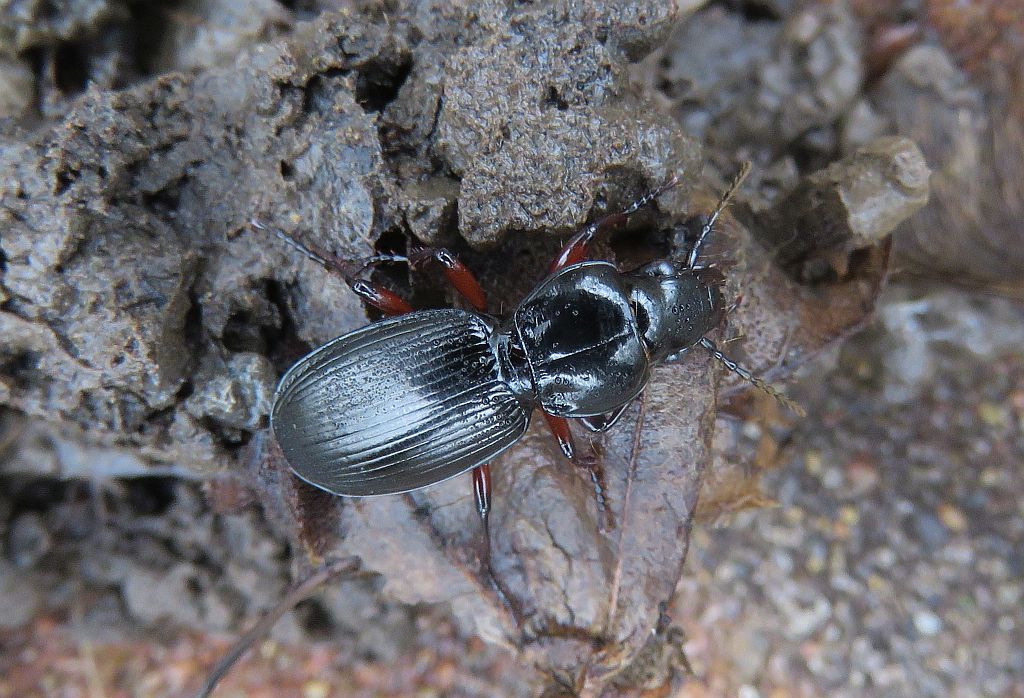 Another first was a Black Clock Beetle Pterostichus madidus. There are two forms, this one with red legs (var. concinnus) and more commonly (the typical form) with black legs. It's very common and, as with most ground beetles, is a predator . Another first was a Black Clock Beetle Pterostichus madidus. There are two forms, this one with red legs (var. concinnus) and more commonly (the typical form) with black legs. It's very common and, as with most ground beetles, is a predator .
17/03/19
In Area 1 by the Emm a Queen Buff tailed bumblebee Bombus terrestris was seen visiting Lesser Celandine. Bombus terrestris is our largest bumblebee, and usually the first to emerge.
09/03/19
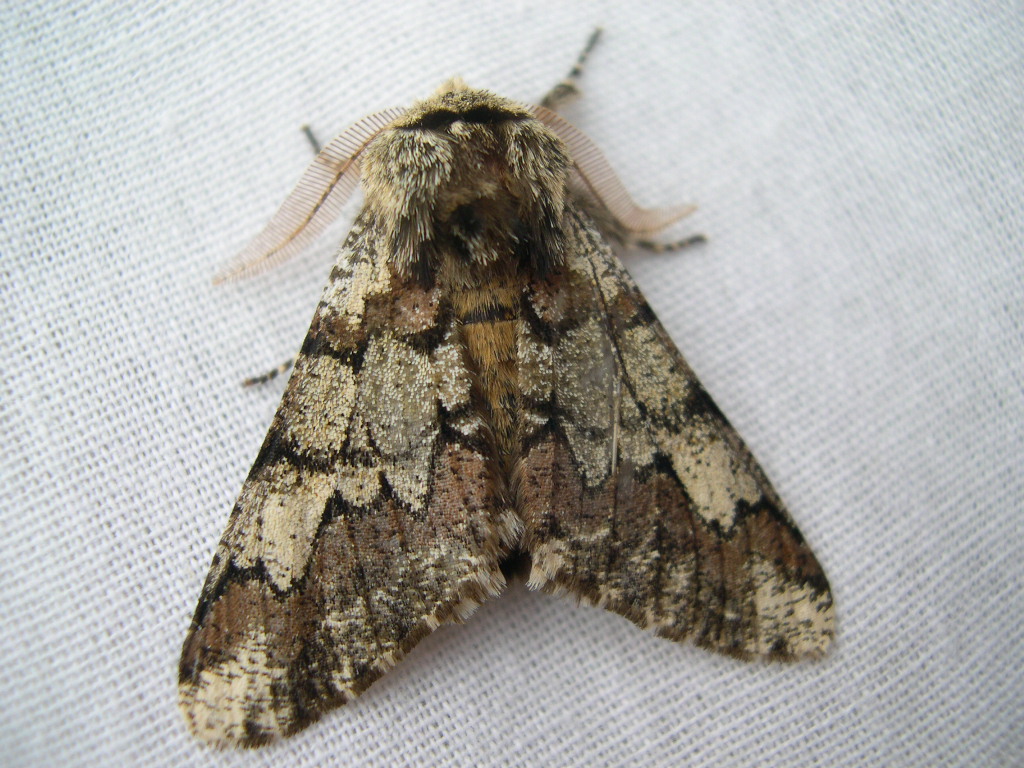 Disturbed in my Area 5 Greenhouse was a Queen Red tailed bumblebee Bombus lapidarius .The moth trap was out but was removed before midnight due to heavy rain. Highlight was a male Oak Beauty Biston strataria The males of some species have enlarged comb like antennae that can detect the pheromones given off by unmated females from as far away as to 2 kilometres . Despite its name the larva feeds on various broad-leaved trees and shrubs, including Oak, Hazel, Aspen, Alder and Elm. A March Moth Alsophila aescularia was the only other moth. Also seen was a Common green lacewing Chrysoperla carnea .The Common Green Lacewing is one of 18 species of green lacewings that live in Britain. Two of these species are actually brownish but all the others are various shades of green. All have long antennae, large golden eyes and two pairs of transparent wings that are held tent-like over the body when at rest. The wings are iridescent when they catch the light and are crossed with a tracery of fine veins giving the wings their lace-like appearance.
Disturbed in my Area 5 Greenhouse was a Queen Red tailed bumblebee Bombus lapidarius .The moth trap was out but was removed before midnight due to heavy rain. Highlight was a male Oak Beauty Biston strataria The males of some species have enlarged comb like antennae that can detect the pheromones given off by unmated females from as far away as to 2 kilometres . Despite its name the larva feeds on various broad-leaved trees and shrubs, including Oak, Hazel, Aspen, Alder and Elm. A March Moth Alsophila aescularia was the only other moth. Also seen was a Common green lacewing Chrysoperla carnea .The Common Green Lacewing is one of 18 species of green lacewings that live in Britain. Two of these species are actually brownish but all the others are various shades of green. All have long antennae, large golden eyes and two pairs of transparent wings that are held tent-like over the body when at rest. The wings are iridescent when they catch the light and are crossed with a tracery of fine veins giving the wings their lace-like appearance.
02/03/19
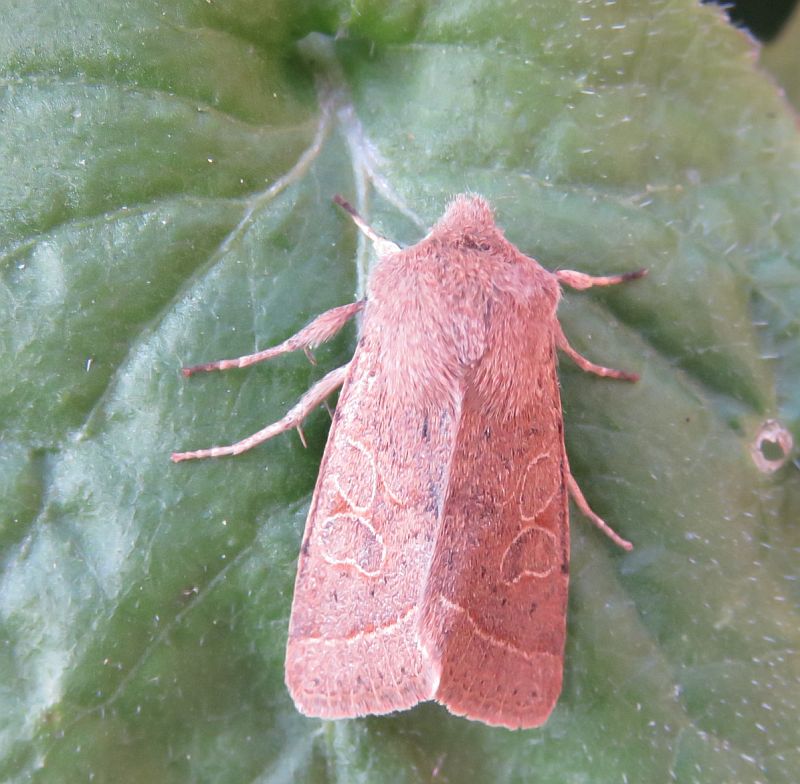 Despite Storm Freya on the horizon I put out the moth trap as night time temperatures were in double figures. It was switched off at 05:30 when the rain started. A reasonable haul was had for the time of the year,3 Common Quaker Orthosia cerasi, 1 Hebrew Charecter Orthosia gothica,
Despite Storm Freya on the horizon I put out the moth trap as night time temperatures were in double figures. It was switched off at 05:30 when the rain started. A reasonable haul was had for the time of the year,3 Common Quaker Orthosia cerasi, 1 Hebrew Charecter Orthosia gothica, 1 Clouded Drab Orthosia incerta, 1 appropriately named March Moth Alsophila aescularia, and a Twin spotted Quaker Anorthoa munda . 1 Clouded Drab Orthosia incerta, 1 appropriately named March Moth Alsophila aescularia, and a Twin spotted Quaker Anorthoa munda .
Plant/Trees
30/03/19
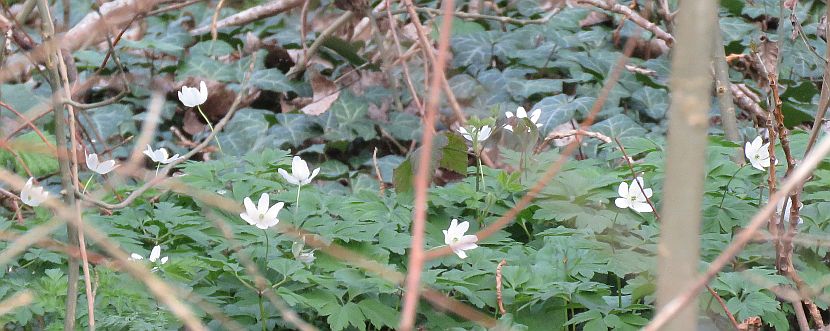 On the opposite side of the bank to the weir pool in Area 5 Wood Anemone Anemone nemorosa are in flower.
On the opposite side of the bank to the weir pool in Area 5 Wood Anemone Anemone nemorosa are in flower.
23/03/19
 Not sure if these are garden escapees or wild, but still nice to see Primrose Primula vulgaris
Not sure if these are garden escapees or wild, but still nice to see Primrose Primula vulgaris 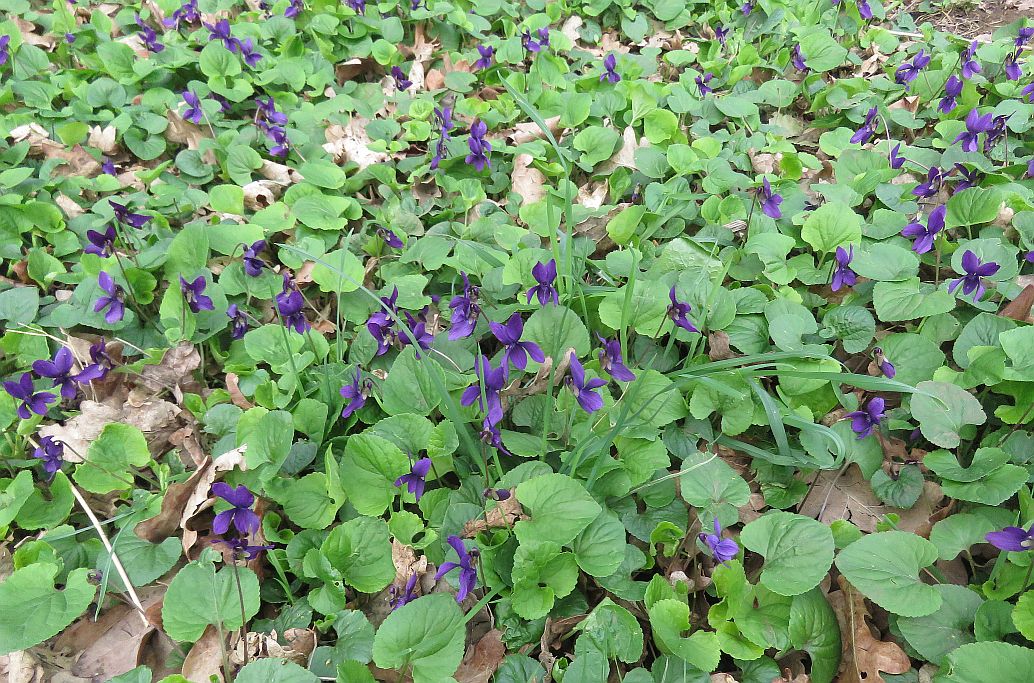 also seen was Common Dog-violet Viola riviniana. If you see a violet in the wild, it is most likely to be the Common Dog-violet. This widespread plant lives happily in many different habitats. It flowers from April to June, but its flowers are not scented, unlike those of its cousin, the Sweet Violet, which was used as a perfume in Ancient Greece.As predicted Marsh Marigold Caltha palustris are now in full bloom by the pond. All plants in Area 5. also seen was Common Dog-violet Viola riviniana. If you see a violet in the wild, it is most likely to be the Common Dog-violet. This widespread plant lives happily in many different habitats. It flowers from April to June, but its flowers are not scented, unlike those of its cousin, the Sweet Violet, which was used as a perfume in Ancient Greece.As predicted Marsh Marigold Caltha palustris are now in full bloom by the pond. All plants in Area 5.
20/03/19
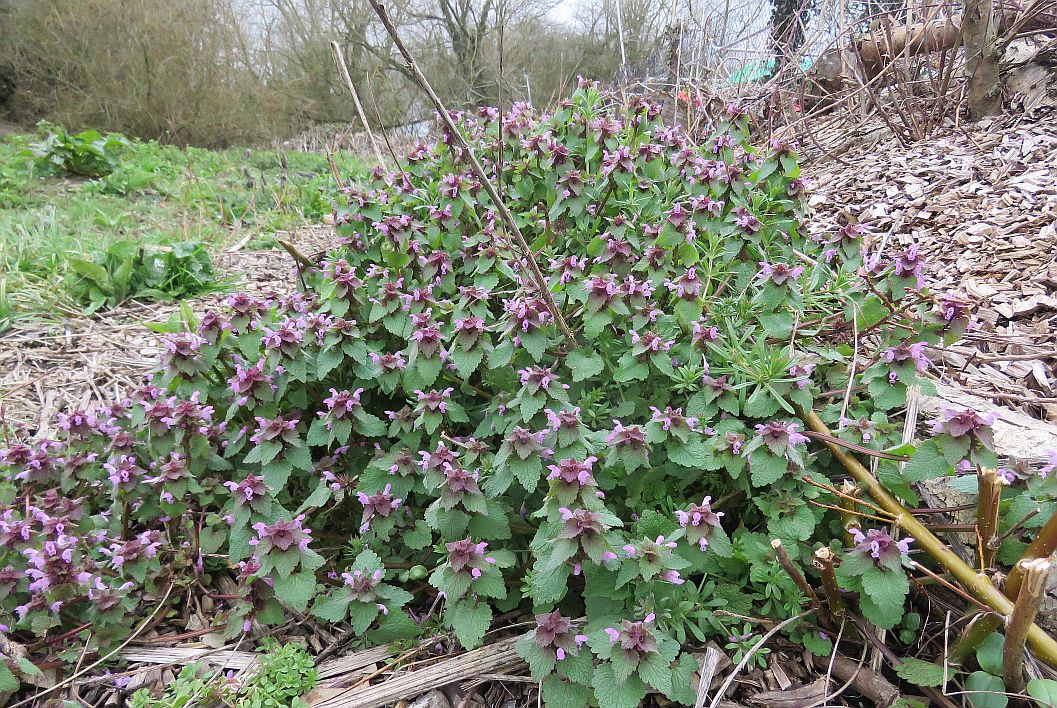 In Area 10 at the Dinton Activity Centre, clumps of Red Dead-nettle Lamium purpureum can be seen near the banks of the Emm.
Despite the family it's from, Red Dead-nettle does not sting. It displays dense clusters of pinky-red flowers in whorls around its stem, and can be found on disturbed ground from March to October.
Lots of different species of long-tongued insects visit the flowers of Red Dead-nettle, including the Red Mason Bee and Bumblebees. The caterpillars of Garden Tiger, White Ermine and Angle Shades moths feed on the leaves.
In Area 10 at the Dinton Activity Centre, clumps of Red Dead-nettle Lamium purpureum can be seen near the banks of the Emm.
Despite the family it's from, Red Dead-nettle does not sting. It displays dense clusters of pinky-red flowers in whorls around its stem, and can be found on disturbed ground from March to October.
Lots of different species of long-tongued insects visit the flowers of Red Dead-nettle, including the Red Mason Bee and Bumblebees. The caterpillars of Garden Tiger, White Ermine and Angle Shades moths feed on the leaves.
17/03/19
 Down by the pond in Area 5 the Marsh Marigold Caltha palustris , are ready to come into flower. In a few days time their yellow flowers will be glowing.Keep an eye out.
Down by the pond in Area 5 the Marsh Marigold Caltha palustris , are ready to come into flower. In a few days time their yellow flowers will be glowing.Keep an eye out.
09/03/19
 Along the Brook Blackthorn Prunus spinosa , is just starting to come into flower. People get confused between Blackthorn and Hawthorn at this time of the year.The easiest way to identify these common plants in the field is to know that Blackthorn flowers appear before its leaves, unlike Hawthorn.
Along the Brook Blackthorn Prunus spinosa , is just starting to come into flower. People get confused between Blackthorn and Hawthorn at this time of the year.The easiest way to identify these common plants in the field is to know that Blackthorn flowers appear before its leaves, unlike Hawthorn.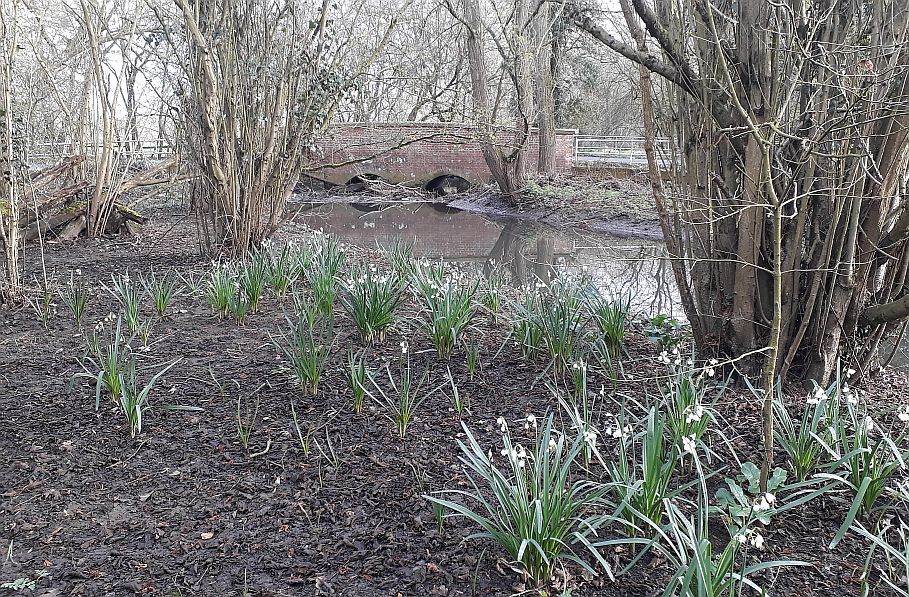 In Area 10 the stand of In Area 10 the stand of Loddon Lily Leucojum aestivum are still putting on a show.
02/03/19
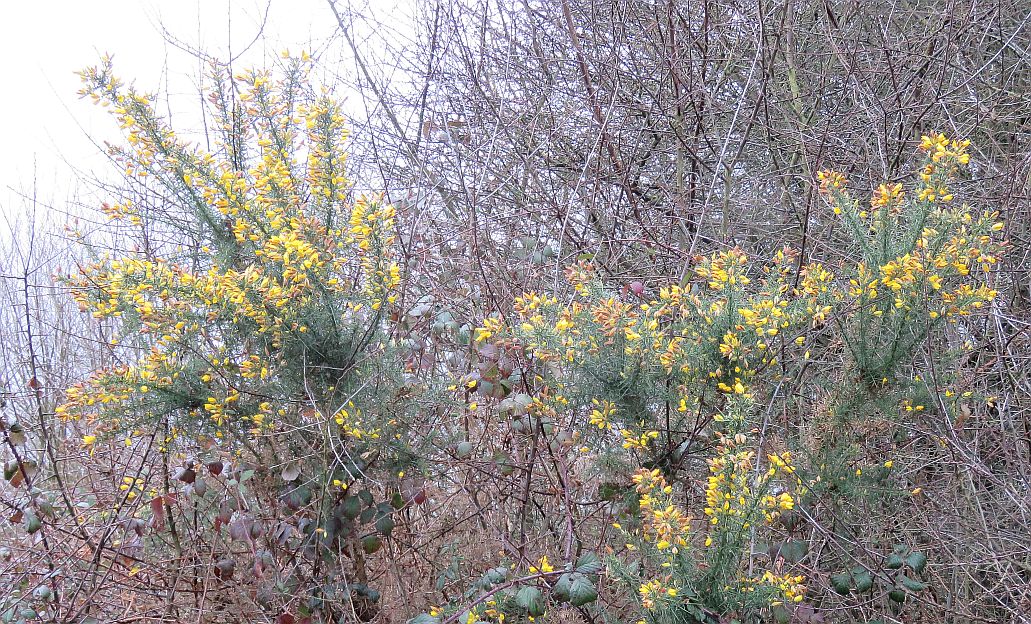 In Area 8,Old Forest Road Meadows, Gorse Ulex europaeus is in flower. It generally flowers from January to June (although it may flower sporadically throughout the year).
In Area 8,Old Forest Road Meadows, Gorse Ulex europaeus is in flower. It generally flowers from January to June (although it may flower sporadically throughout the year).
Why do leaves change colour
|
Other Wildlife
Amphibians and Reptiles
21/03/19
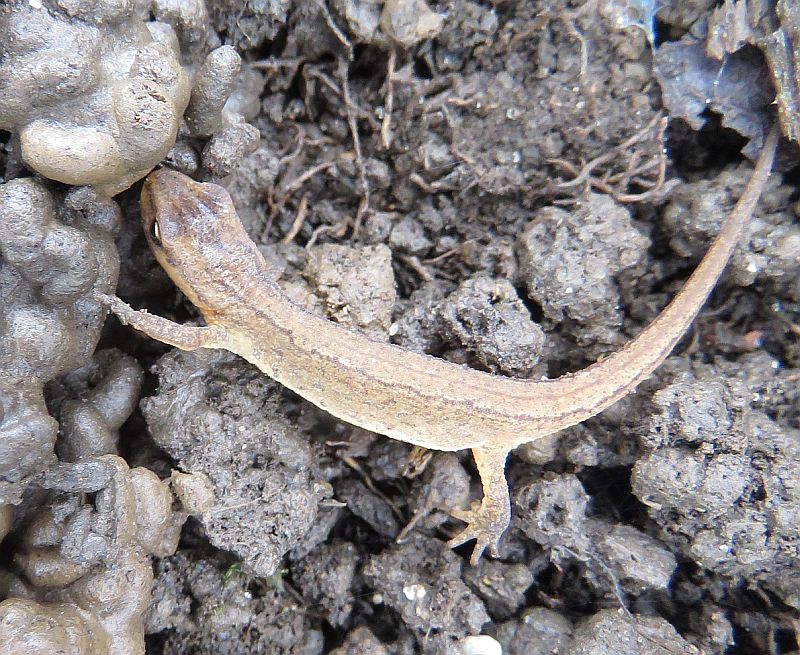 An as yet unidentified Newt species was seen whilst on a Bug Hunt in Area 10.
An as yet unidentified Newt species was seen whilst on a Bug Hunt in Area 10.
Mammals
26/03/19
 Getting up early this morning, and visiting Area 10 paid dividends. At the edge of the landfill close to the Emm, 3 Roe Deer Erinaceus europaeus were feeding .
Getting up early this morning, and visiting Area 10 paid dividends. At the edge of the landfill close to the Emm, 3 Roe Deer Erinaceus europaeus were feeding .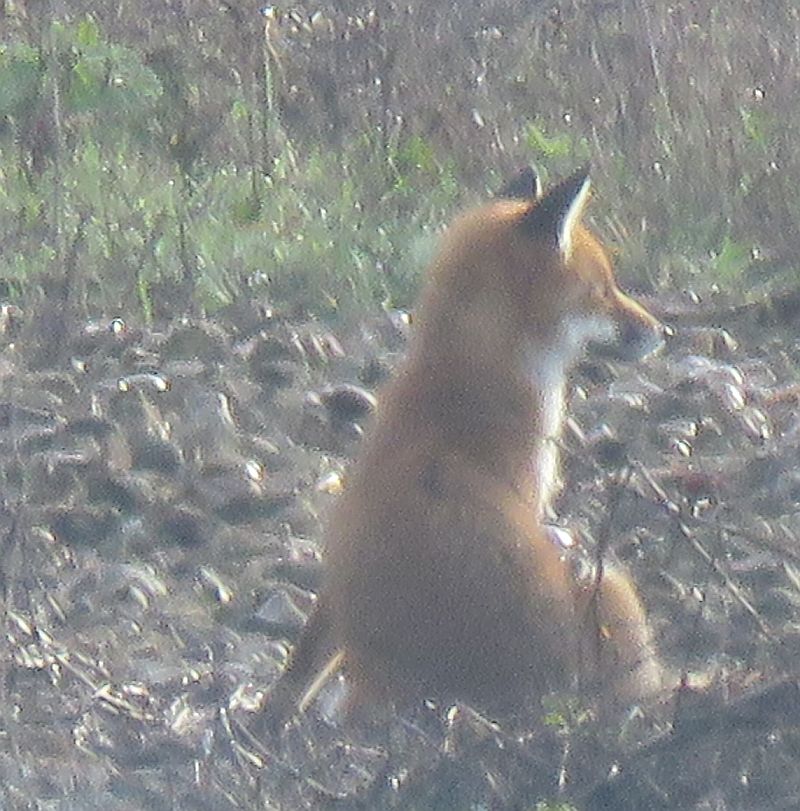 A Red Fox Erinaceus europaeus which was sleeping, woke and strolled off, no doubt to look for breakfast. Both animals were distant, hence the grainy photo's. A Red Fox Erinaceus europaeus which was sleeping, woke and strolled off, no doubt to look for breakfast. Both animals were distant, hence the grainy photo's.
23/03/19
A Wood Mouse Apodemus sylvaticus was seen in my Area 5 garage feeding on the bird fat balls.
18/03/19
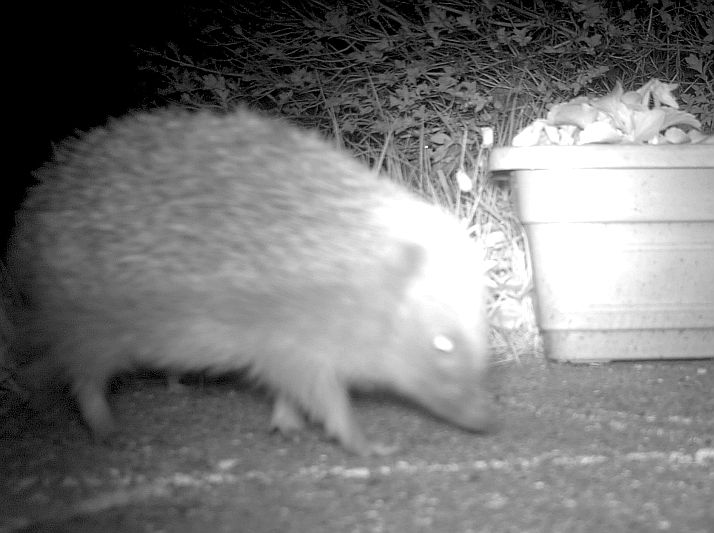 At 01:40 this morning, I managed to catch a European hedgehog Erinaceus europaeus on my garden trailcam in Area 5 .
At 01:40 this morning, I managed to catch a European hedgehog Erinaceus europaeus on my garden trailcam in Area 5 .
09/03/19
 With the poo of a European hedgehog Erinaceus europaeus seen a couple of days ago, I was fairly sure at least 1 was about and put out my garden trailcam. Sure enough it obliged at 21:15.The first of the year.
With the poo of a European hedgehog Erinaceus europaeus seen a couple of days ago, I was fairly sure at least 1 was about and put out my garden trailcam. Sure enough it obliged at 21:15.The first of the year.
03/03/19
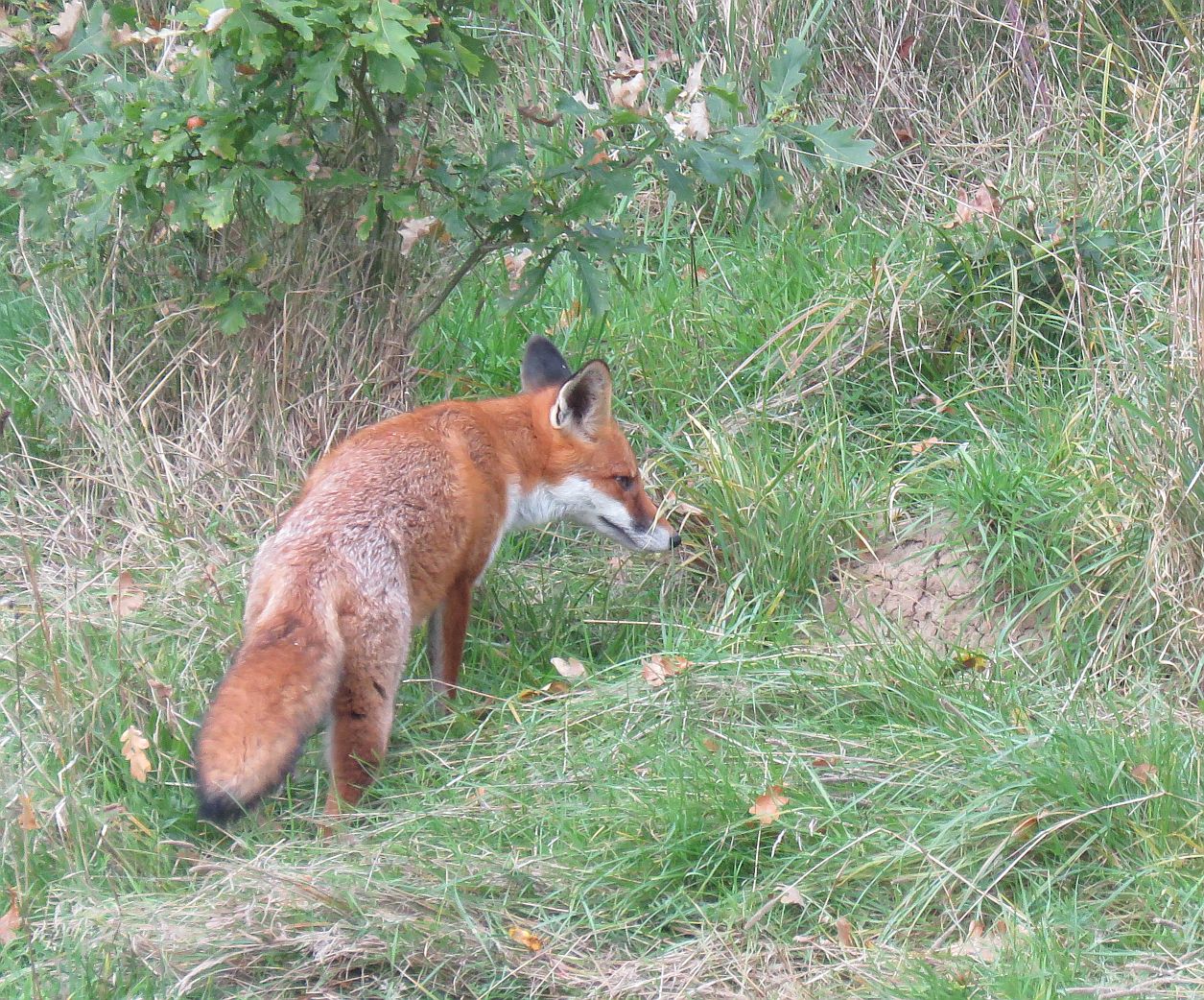 It's a busy time of year for Foxes Vulpes vulpes
In the next few weeks the females will be giving birth and in spring and early summer they are perhaps most visible while trying to feed the cubs and after the the cubs leave the den. One of the surprises of the last 50 years was the ability to foxes to adapt to urban environments, but cities still form a relatively small proportion of land-use – most of the UK is still agricultural land and woodland. it's not clear how foxes are faring in the in the countryside, so the Mammal Society is asking the public to help them monitor foxes. Now is a great time of year to do it because there is still a lot of night - many are still commuting to and from work in the dark. It doesn’t matter whether you live in the countryside or the city, remarkably, we still have very little idea of total numbers of urban or rural foxes. To help, the Mammal Society with sightings
Click on the link
Mammal Survey
It's a busy time of year for Foxes Vulpes vulpes
In the next few weeks the females will be giving birth and in spring and early summer they are perhaps most visible while trying to feed the cubs and after the the cubs leave the den. One of the surprises of the last 50 years was the ability to foxes to adapt to urban environments, but cities still form a relatively small proportion of land-use – most of the UK is still agricultural land and woodland. it's not clear how foxes are faring in the in the countryside, so the Mammal Society is asking the public to help them monitor foxes. Now is a great time of year to do it because there is still a lot of night - many are still commuting to and from work in the dark. It doesn’t matter whether you live in the countryside or the city, remarkably, we still have very little idea of total numbers of urban or rural foxes. To help, the Mammal Society with sightings
Click on the link
Mammal Survey
Molluscs
21/03/19
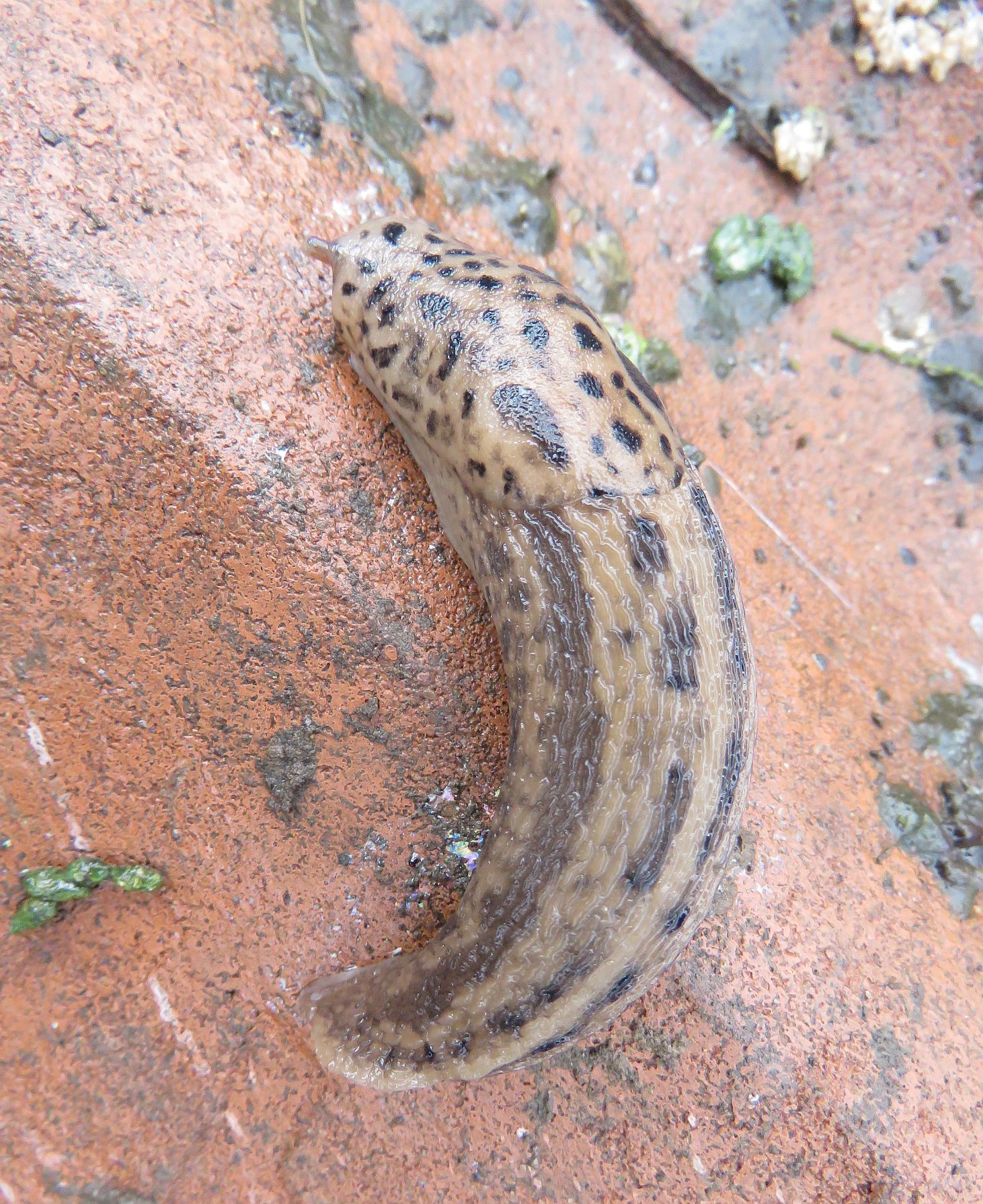 Whilst on a Bug Hunt in Area 10 a Leopard Slug Limax maximus was found under fallen tree branches.
Whilst on a Bug Hunt in Area 10 a Leopard Slug Limax maximus was found under fallen tree branches.  These Slugs are usually strikingly marked but quite variable, this is one of the largest British slugs reaching up to 150 mm. Spots on the back are usually oriented in three longitudinal bands. Also seen was Yellow Slug Limacus flavus. These Slugs are usually strikingly marked but quite variable, this is one of the largest British slugs reaching up to 150 mm. Spots on the back are usually oriented in three longitudinal bands. Also seen was Yellow Slug Limacus flavus.
Fish
Fungi
|









































